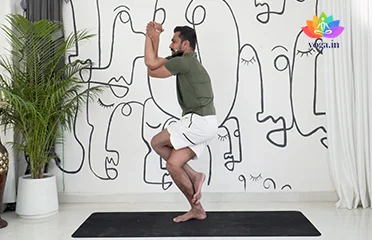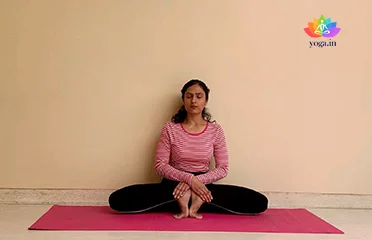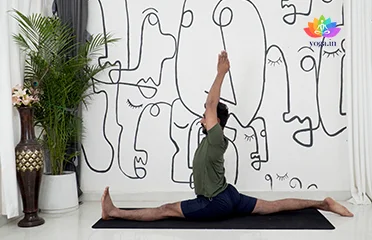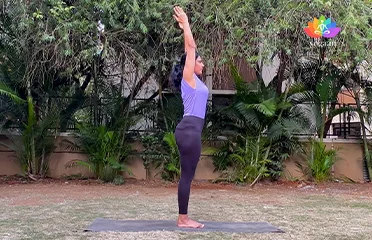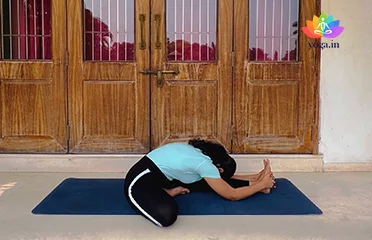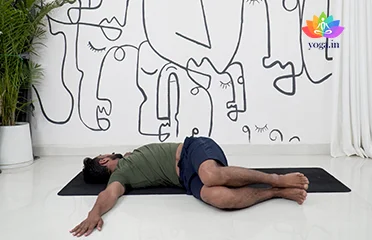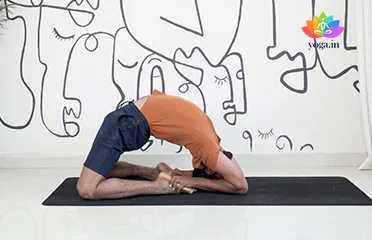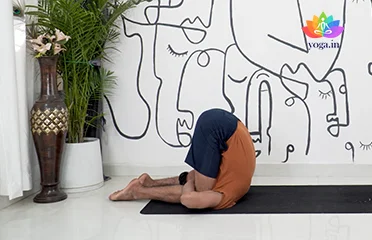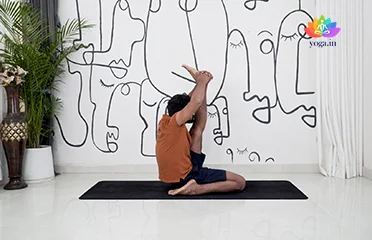Garudasana (Eagle Pose)
गरुडासन / Eagle Pose
The Sanskrit name is derived from Garuda (गरुडा) meaning eagle and [�K]
Gomukhasana (Cow Face Pose)
गोमुखासन / Cow Face Pose
The Sanskrit name is derived from Gau (गो) meaning cow, Mukh meaning face [�K]
Gorakshasana (Cowherd Pose)
गोरक्षासन / Cowherd Pose
The Sanskrit name is derived from the word Goraksha (गोरक्षा) [�K]
Hanumanasana (Monkey Pose)
हनुमानासन / Monkey Pose
The Sanskrit name is derived from the Hindu God -Hanuman (हनुमान) [�K]
Hastapadasana (Hand to Foot Pose)
हस्तपदासन / Hand to Foot Pose
The sanskrit name is derived from hasta (हस्त) means hands, pada (पदा) [�K]
Janusirsasana (Head to Knee Pose)
जानुशीर्षासन / Head to Knee Pose
The Sanskrit name is derived from (जानु) Janu means knee, Sirsa (शीर्षा) [�K]
Jathara Parivartanasana (The Abdominal T
ञठर परिवर्तनासन / The Abdominal Twist
The Sanskrit name is derived from Jathara (ञठर) meaning belly or abdomen, [�K]
Kapotasana (Pigeon Pose)
कपोटासन / Pigeon Pose
The Sanskrit name is derived from Kapota (कपोटा) meaning pigeon or [�K]
Karnapidasana (Ear Pressure Pose)
कर्णपीडासन / Ear Pressure Pose
The Sanskrit name is derived from Karna (कर्ण) meaning ear, Pida (पीडा) [�K]
Kraunchasana (Heron Pose)
क्रौञ्चासन / Heron Pose
The Sanskrit name is derived from Kraunch (क्रौञ्च) meaning heron [�K]
- 1
- 2
- 3
- 4
- 5
- ...
- 6
- 7
- ...
- 8
Yoga Poses for Healthy Knees: Find Relief and Strength
Knee pain can be a frustrating and limiting issue. But fear not! Yoga offers a range of poses specifically designed to strengthen the muscles around your knees, improve flexibility, and even alleviate pain.
How Yoga Can Help Your Knees:
Yoga works its magic on your knees in several ways:
- Strengthens Supporting Muscles: Gentle, targeted poses build strength in the quads, hamstrings, and calves, which provide stability and support to your knee joint.
- Improves Flexibility: Tight muscles can pull on your knees and cause discomfort. Yoga stretches gently to increase flexibility and range of motion.
- Reduces Pain: By improving circulation and promoting relaxation, yoga can help reduce inflammation and ease knee pain.
Understanding Knee Issues:
Knee pain can arise from various conditions, including:
- Osteoarthritis: The breakdown of cartilage in the knee joint, causing pain and stiffness.
- Tendinitis: Inflammation of the tendons around the knee.
- Ligament Sprains: Stretching or tearing of ligaments supporting the knee joint.
- Meniscus Tears: Damage to the cartilage within the knee joint.
Yoga Poses for Knee Relief:
While some poses might aggravate certain knee conditions, here are a few safe and beneficial options:
- Warrior II (Virabhadrasana II): Strengthens legs and improves balance. Stand with a lunge, front knee bent at 90 degrees, back leg straight. Raise your arms overhead.
- Chair Pose (Utkatasana): Builds quad strength and improves stability. Stand with feet hip-width apart, squat down as if sitting in a chair, arms extended forward.
- Bridge Pose (Setu Bandhasana): Opens the hips and strengthens glutes, supporting the knees. Lie on your back, knees bent, feet flat on the floor. Lift your hips off the ground.
Diet for Healthy Knees:
- Hydration: Drink plenty of water throughout the day to stay hydrated. Dehydration can contribute to constipation and worsen pelvic floor symptoms. Aim for at least eight glasses of water daily.
- Fruits and Vegetables: Include a variety of colorful fruits and vegetables in your diet. They provide essential vitamins, minerals, and fiber that promote gut health and digestion, which can indirectly benefit pelvic floor function.
- Whole Grains: Opt for whole grains like brown rice, quinoa, and oats over refined grains. Whole grains are a good source of fiber, which helps regulate digestion and bowel movements, reducing strain on the pelvic floor.
- Legumes: Include lentils, beans, and chickpeas in your diet. Legumes are a great source of plant-based protein, essential for building and maintaining muscle strength.
- Healthy Fats: Don’t shy away from healthy fats found in avocados, nuts, and seeds. Healthy fats aid in hormone regulation and can contribute to overall knee health.
Remember:
- Listen to Your Body: If any pose causes pain, stop immediately and consult a healthcare professional before continuing.
- Modify as Needed: Use props like blocks or blankets for added support and adjust poses for your comfort level.
Additional Tips:
- Warm Up: Before practicing, perform gentle stretches to prepare your knees for movement.
- Cool Down: After your practice, include stretches to improve flexibility and prevent stiffness.
- Seek Guidance: Consider working with a yoga therapist experienced in knee conditions for personalized recommendations.


